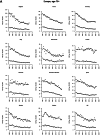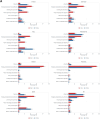Late-life suicide trends in selected major countries worldwide in 1990-2022: a spatio-temporal analysis from the WHO mortality database
- PMID: 40453538
- PMCID: PMC12123361
- DOI: 10.1016/j.eclinm.2025.103230
Late-life suicide trends in selected major countries worldwide in 1990-2022: a spatio-temporal analysis from the WHO mortality database
Abstract
Background: Suicide is a major and largely preventable public health issue, with rates increasing among people in later life. We aimed to describe global temporal and geographical patterns of suicide mortality among older adults.
Methods: Using the WHO mortality database (latest update: February 2024), we analysed suicide data for individuals aged 75 or older from 1990 to 2022. We selected countries based data availability, completeness, and number of suicide deaths. We computed annual age-standardised suicide mortality rates (ASR) by sex and country, and performed joinpoint regression analyses on a subgroup of major countries and geographical areas.
Findings: We considered suicide data at age 75+ from 48 countries, the EU (27 Member States) and seven geographical areas, and analysed trends in a subgroup of 20 major countries and the areas. Late-life suicide patterns differed across countries, with rates 3-7 times higher among males than females. Several countries showed steady declines by -2% to -6% annually, while in other countries like Germany, Italy, the Netherlands, the UK and Australia (males), trends slowed or stopped declining after around 2010. Increases were observed in the USA, Brazil (females), and Australia (females). Among males, the most recent highest ASR was 50.9/100,000 (95% CI: 48.1-53.7) in Centre-East Europe, while the lowest one was 12.8/100,000 (95% CI: 11.9-13.7) in North Europe. The male ASR in the EU-27 was 38.9/100,000 (95% CI: 38.0-39.9). Country-specific ASRs ranged from 10.4/100,000 (95% CI: 9.1-11.7) in the UK to 99.3/100,000 (95% CI: 93.3-104.8) in South Korea. Among females, the highest ASR was 14.4/100,000 (95% CI: 13.8-15.1) in Asia and Oceania while the lowest one was 2.4/100,000 (95% CI: 2.1-2.7) in Centre-South America. The EU-27 female rate was 8.1/100,000 (95% CI: 7.7-8.5). Country-specific ASRs ranged from less than 1 death per 100,000 in Mexico to 29.0/100,000 (95% CI: 26.8-31.3) in South Korea.
Interpretation: Suicide mortality shows substantial variations in rates and trends worldwide. However, data are subject to variable misclassification and underreporting in different countries and geographic areas, and therefore require cautious interpretation.
Funding: Ministry of University and Research - Decree No. 1159 of July 23, 2023 - PROBEN call.
Keywords: Global; Late-life; Mortality; Official statistics; Suicide; Trends.
© 2025 The Authors.
Conflict of interest statement
Andrea Aguglia has received payment by Lundbeck, Viatris, Angelini pharma. Maurizio Pompili wishes to disclose that in the last five years, received lectures and advisory board honoraria or has engaged in clinical trial activities with Angelini Pharma, Allergan, Janssen, Lundbeck, Merck Sharp and Dohme, Otsuka, Rovi, Pfizer Inc, Fidia, Viatris, Recordati, Boehringer Ingelheim, Newron, GSK, Abbvie, Neopharm Gentili, and Teva, all of which are unrelated to this article. Mauriizio Pompili received support for attending meetings and/or travel by Otsuka Pharmaceutical and Johnson & Johnson (J&J).
Figures






References
-
- Suicide worldwide in 2019. https://www.who.int/publications/i/item/9789240026643
-
- Alicandro G., Malvezzi M., Gallus S., La Vecchia C., Negri E., Bertuccio P. Worldwide trends in suicide mortality from 1990 to 2015 with a focus on the global recession time frame. Int J Public Health. 2019;64:785–795. - PubMed
-
- Pompili M., Vichi M., Innamorati M., et al. Suicide in Italy during a time of economic recession: some recent data related to age and gender based on a nationwide register study. Health Soc Care Commun. 2014;22:361–367. - PubMed
-
- GBD 2019 Injuries Collaborators Global, regional, and national burden of injuries, and burden attributable to injuries risk factors, 1990 to 2019: results from the Global Burden of Disease study 2019. Public Health. 2024;237:212–231. - PubMed
LinkOut - more resources
Full Text Sources
Miscellaneous

